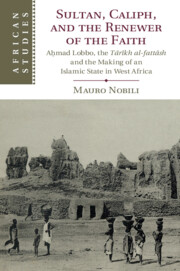 Sultan, Caliph, and the Renewer of the Faith
Sultan, Caliph, and the Renewer of the Faith Book contents
- Sultan, Caliph, and the Renewer of the Faith
- African Studies Series
- Sultan, Caliph, and the Renewer of the Faith
- Copyright page
- Dedication
- Contents
- Figures
- Maps
- Tables
- Acknowledgments
- Notes on Orthography and Other Conventions
- Introduction
- Part I A Nineteenth-Century Chronicle in Support of the Caliphate of Ḥamdallāhi: Nūḥ b. al-Ṭāhir’s Tārīkh al-fattāsh
- 1 A Century of Scholarship
- 2 The Tārīkh al-fattāsh: A Nineteenth-Century Chronicle
- Part II A Contested Space of Competing Claims
- Part III The Circulation and Reception of the Tārīkh al-fattāsh, 1840s–2010s
- Index
- African Studies Series
2 - The Tārīkh al-fattāsh: A Nineteenth-Century Chronicle
from Part I - A Nineteenth-Century Chronicle in Support of the Caliphate of Ḥamdallāhi: Nūḥ b. al-Ṭāhir’s Tārīkh al-fattāsh
Published online by Cambridge University Press: 28 February 2020
- Sultan, Caliph, and the Renewer of the Faith
- African Studies Series
- Sultan, Caliph, and the Renewer of the Faith
- Copyright page
- Dedication
- Contents
- Figures
- Maps
- Tables
- Acknowledgments
- Notes on Orthography and Other Conventions
- Introduction
- Part I A Nineteenth-Century Chronicle in Support of the Caliphate of Ḥamdallāhi: Nūḥ b. al-Ṭāhir’s Tārīkh al-fattāsh
- 1 A Century of Scholarship
- 2 The Tārīkh al-fattāsh: A Nineteenth-Century Chronicle
- Part II A Contested Space of Competing Claims
- Part III The Circulation and Reception of the Tārīkh al-fattāsh, 1840s–2010s
- Index
- African Studies Series
Summary
This chapter presents the reader with the Tārīkh al-fattāsh, an indispensable source for understanding the Middle Niger in the nineteenth century. It first introduces its author, Nūḥ b. al-Ṭāhir, and his writings. Then, it exposes Nuḥ b. al-Ṭāhir’s skillfulness in embedding new pieces of writing into an older chronicle, the seventeenth-century “Chronicle of Ibn al-Mukhtār,” to produce a masterful work in support of his patron, Aḥmad Lobbo. The latter is portrayed as sultan, the authoritative ruler of West Africa and the last of a long line of legitimate rulers modelled on Askiyà Muḥammad, the foremost Askiyà emperor of the Songhay; as the twelfth of the caliphs under whom the Islamic community would thrive, according to a ḥadīth ascribed to the Prophet; and as “renewer” of Islam, who, according to another Prophetic tradition, is sent every one hundred years by God to prevent the Muslim community from going astray.
Keywords
- Type
- Chapter
- Information
- Sultan, Caliph, and the Renewer of the FaithAhmad Lobbo, the <I>Tārīkh al-fattāsh</I> and the Making of an Islamic State in West Africa, pp. 77 - 122Publisher: Cambridge University PressPrint publication year: 2020


